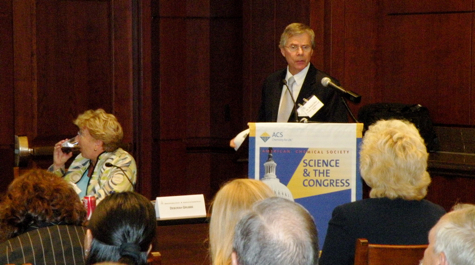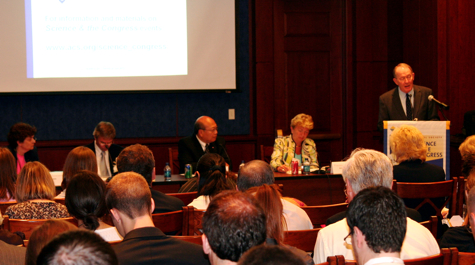Diaz briefs Congress on environmental effects of oil dispersants
Professor Bob Diaz of the Virginia Institute of Marine Science, College of William and Mary, today briefed Congress on the ecological effects of the chemical dispersants used in the Gulf oil spill.
The briefing, organized by The American Chemical Society and the American Institute of Chemical Engineers, was opened by Senator Lamar Alexander (R-TN), a member of the Senate Committee on Environment and Public Works. The briefing was hosted by the U.S. Senate's Science and Technology Caucus.
Oil dispersants work like dishwashing detergent, breaking oil into droplets that mix more easily with the surrounding water. They are designed to break up surface oil slicks, thereby reducing damage to the shoreline; protecting animals such as sea turtles that spend extensive time at the ocean surface; and increasing the rate at which microbes can consume the hydrocarbons. To date, BP has released approximately 2 million gallons of dispersants into the Gulf.
Ecological Trade-Offs
Diaz, an ecologist with expertise in bottom-dwelling communities and low-oxygen marine "dead zones," briefed members of the Congress and their staff on the ecological trade-offs inherent in dispersant use.
"Applying dispersants represents a decision to increase the hydrocarbon load on one part of the ecosystem while reducing the load on another," said Diaz. "It decreases risk at the surface and shoreline while increasing potential risk to organisms in the water column and on the seafloor."
Diaz stressed that assessing the long-term risks and impacts of dispersant use will require study of the Gulf ecosystem as a whole. He says "We now have small drops of oil dissolved throughout the water column in large areas of the Gulf, so resident organisms can encounter oil during different stages of their life cycle, and throughout the food chain."
As an example, Diaz noted that white, pink, and brown shrimp—important targets of the Gulf fishing industry—all spawn offshore, with juveniles subsequently moving into coastal nursery areas. He said that crab larvae—important food for many other species—have already been found with droplets of oil under their shell.
Diaz noted that migratory animals—including Atlantic bluefin tuna—enter Gulf waters during sensitive parts of their life cycle. "The Gulf of Mexico is an important spawning and nursery habitat for these fish," says Diaz. "They're drawn by the Gulf's warm waters, abundant prey, and Sargassum—a type of floating seaweed that harbors an ecosystem of its own."
Diaz also noted that scientists' understanding of the environmental effects of dispersants decreases with depth. "We've done toxicity testing on shallow-water species that are easily grown or kept," said Diaz, "so the risks that dispersants pose to surface species are pretty well understood. But as we move from marshes to the deep-sea, our knowledge declines sharply."
He cautioned that dispersed oil could reach the bottom along with sinking sediment, potentially affecting the coldwater coral ecosystems of the deep Gulf. These unique habitats, in depths exceeding 1,000 feet, feature a diverse community that includes coldwater corals such as Lophelia pertusa and Madrepora oculata.
During his briefing, Diaz also discussed biodegradation—the process by which bacteria and other microorganisms metabolize the various compounds in petroleum. Diaz noted that the biodegradation depends on the type of dispersant used, its application method and rate, the type of crude oil present, and the composition of the microbial community.
Oxygen & Dead Zones
He emphasized that breakdown of dispersed oil depends on the availability of oxygen in both the water and sediment. "There are two main low-oxygen zones in the Gulf," says Diaz. "There's a seasonal ‘dead zone' on the continental shelf fueled by human input of nutrients to the Mississippi watershed, and a naturally occurring ‘oxygen minimum zone' that intersects the continental slope at depths from around 600 to 2,300 feet."
Diaz says there are two main questions related to these low-oxygen zones: first, whether there's enough oxygen in the water or sediments to fuel the metabolism needed to degrade the oil, and second, to what degree biodegradation will further exacerbate the low-oxygen zones. Scientists are actively pursuing both questions.
Because metabolic rates decrease with both water temperature and depth, Diaz says the efficiency of oxygen depletion decreases with depth as well. He estimates that microbes would require 187 barrels of oil per square kilometer to lower oxygen levels by 10 per cent in the Gulf's surface waters (0 to 600 feet), 400 barrels/km2 for a 10 per cent oxygen reduction between 600 and 2,400 feet, and 650 barrels/km2 from 2,400 to 4,500 feet. His estimates assume that the oil is uniformly distributed throughout the water column.
Science and the Congress
The briefing was part of the American Chemical Society's ongoing Science & the Congress program, which was established in 1995 to provide a neutral and credible source of scientific information targeted to policymakers on Capitol Hill. The program has offered more than 120 briefings to date.
Videos of the briefing are available on the ACS Science & the Congress website.
The briefing was moderated by Deborah Grubbe, Chair of the Institute for Sustainability and President of Operations and Safety Solutions, LLC. The other panelists were Kenneth Lee, Executive Director of the Centre for Offshore Oil, Gas and Energy Research, Fisheries and Oceans Canada; and Nancy Kinner, Co-Director of the Coastal Response Research Center at the University of New Hampshire.
Diaz first studied dispersants in the late 1970s, when the U.S. Department of the Interior asked VIMS to conduct a large-scale ecological study of Virginia's outer continental shelf in light of interest in offshore domestic drilling following the 1973 oil crisis.




